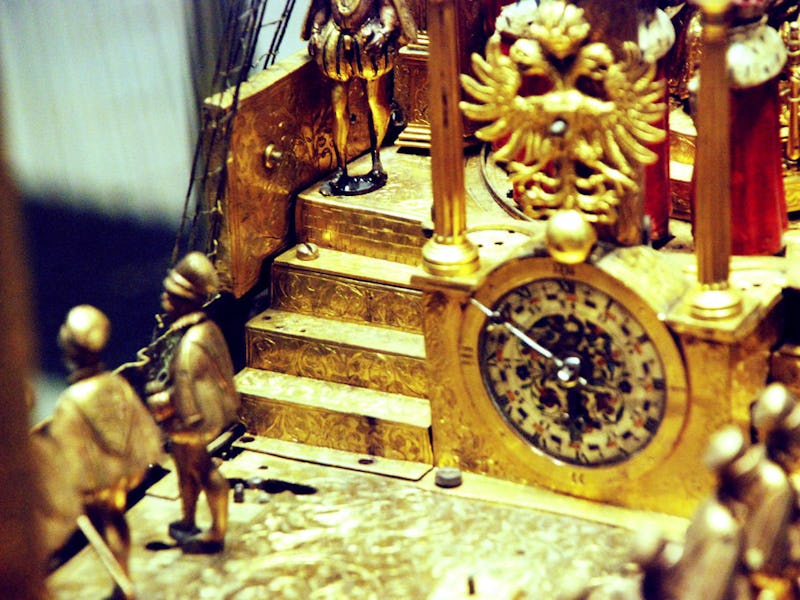How Clockwork Automata Conquered Europe Before the First Robot War
People have used machines as a means to understand consciousness for centuries.

The Silver Swan sits on a stream made of twisted glass rods and within a clear glass box. It preens and stares intently into its fabricated pond before swallowing up a little silver fish. When Mark Twain saw the swan at an exhibition in Paris in 1867 he described it as having “a living grace about his movement and a living intelligence in his eyes.”
But the swan Twain describes wasn’t actually living at all. On display today at the Bowes Museum in England, the Silver Swan is an automata, a self-operating machine designed to automatically follow predetermined instructions. Had it beenbuilt in 2016 instead of 1773, people may have described it with a different word: robot.
“I would say the associations are different, but they refer to the same thing, which is a machine or an artificial entity that does things like a living thing would do,” Stanford professor Jessica Riskin tells Inverse. “Robot is a new word for an old thing.”
Before we had Floka the emotive robot, or the Furby, whose creator believes it is in some ways alive, humans were simultaneously perplexed and dazzled by defecating ducks and mechanical singing birds. These automata from earlier centuries, says Riskin — who addresses the subject in her most recent book The Restless Clock — prompted people to think about the relationship between machines and life.
In a similar way, the technological progress of robots makes us consider the same questions today. Is there much difference in the mindset between the crowds who thought Jacques Vaucanson’s mechanical duck could actually reflect how life came to be and the crowds of people today who believe “sophisticated autonomous robots” should have the rights of the living?
The life-size swan is controlled by three clockwork mechanisms.
As early as 3000 B.C.E., Egyptian water clocks were equipped with human figurines that struck bells at each hour while complex mechanical devices are believed to have existed throughout Hellenistic Greece (though the Anikythera mechanism is our only evidence).
In the 18th century, creators of automata were focused on creating, as Riskin puts it, the “illusion of life” — with organic materials like leather, papier-mâché, and wood engineers whose sole goal was to create machines that were as life-like as possible. Examples of these include the “Lady-Musician” whose eyes follow her fingers and who “breathes” in time to the music she plays on a harpsichord, and the boy-automata who can write up to 40 letters, both built by Swiss inventor Pierre Jaquet-Droz.
An illustration of the elephant clock in Al-Jazari's 13th century book.
Automata made its European debut in the 1600s, thanks to churches fervently sponsoring the technology behind lifelike machines. Soon enough, mechanical devils and angels began to show up in European villages. Flocks of pilgrims made the trek to the Boxley Abbey in Kent, where a mechanical Christ on a crucifix was hung between Easter and the Ascension.
European automata moved on, though, becoming more fanciful: as fixtures within elaborate fountains, replete with mechanical people and golden birdcages with “flying” sparrows. These seemingly frivolous objects set the stage for the major technological developments to come and helped establish a precedent for the relationship between technology, entertainment, and wealth.
“We still see that today, this connection between the world of entertainment and the world of industrial application, applied technology and applied science,” says Riskin. “There were philosophical and financial motivations for both the people who built the machines and for the people who came to see them.”
Automata designed by Jaquet-Droz.
The word “robot” didn’t become a part of our vernacular until 1921, making its debut in the play Rossum’s Universal Robots by Czech playwright Karel Capek. It was derived from the Czech robotnik, which translated roughly to a forced worker, a drudge. While automata conjured images of mechanical creatures, robots were meant to stir a portrait of android versions of humans working on factory assembly lines, itching to rebel against their human masters.
“The word ‘robot’ was associated with a kind of criticism of mechanization and automation of different processes,” Riskin said of the word’s initial negative connotation. “It was a sort of criticism of the industrializing world.”
In 1979, the Robot Institute of America described a robot as a “reprogrammable, multifunctional manipulator designed to move material, parts, tools, or specialized devices through various programmed motions for the for the performance of a variety task.” Mike Brady at the University of Oxford defines robotics more simply as a “field concerned with the intelligent connection of perception to action.”
While the robots today are obviously more advanced and can do some extraordinary things, we’re still surrounded by automata, Riskin insists. “The root of automata just means ‘self-moving,’ a machine that moves itself and directs itself. We are surrounded by drones and self-driving cars and machines that move themselves in various ways. Automata is all over the place.”